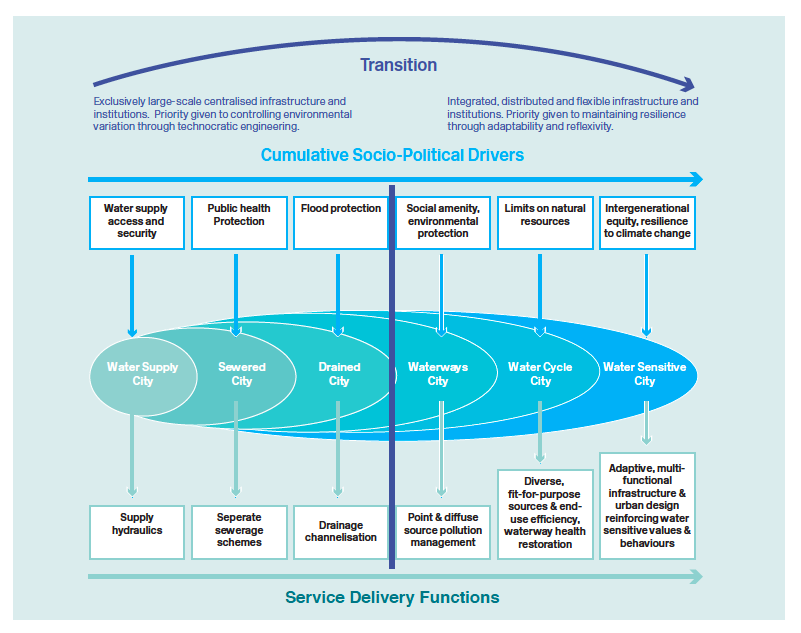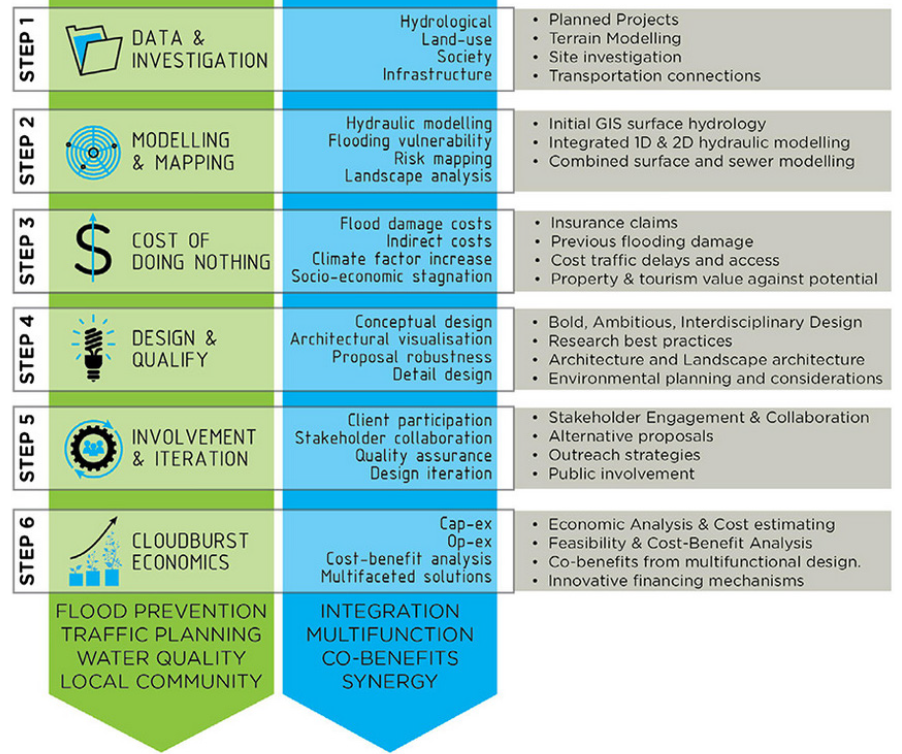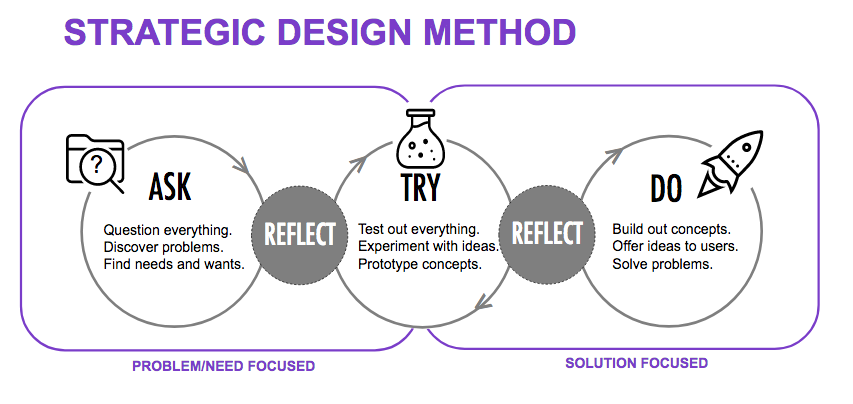Module 12: Leadership for GI
Congratulations! You have arrived at the end of your learning journey. Now is the time to take stock of your learning and to consider what kind of leadership you can bring to moving the GI conversation forward. We know from research that a focus on technical innovation will not be enough to realize a full integration of GI systems in how urban centres approach water management. It is also important to understand the social and institutional dynamics that underlie any city’s attempt at integration. In the article ‘Moving toward Water Sensitive Cities ‘ we revisit a framework for what a water sensitive city can look like, and what the motivations, drivers and arguments are for each phase in the transition.
Source: From page 12 of Moving Toward a Water Sensitive City, 2016.
For change to happen in small and big ways, shifts will be needed in several domains to bridge units and organizations: in the actors who participate (including professionals working in diverse sectors) and the public. We need interdisciplinary knowledge, innovative projects and the use of diverse policy and planning tools. (Toward a Water Sensitive City, p 16).
What is the leadership that is needed to make this happen? At its core GI leadership is interdisciplinary. All professional disciplines in both the public and private sector are required. Such leadership will require having a vision and a narrative that focuses on the quality of life that GI brings to an urban setting. In a recent report prepared by Danish researcher Helleshøj Sørensen, who studied the water resilience, water systems and urban qualities of Vancouver, Rotterdam and Copenhagen, she outlines the important role that compelling water narratives, the professions and an engaged community play in the blue-green transition.
Many of the writers and practitioners in the GI field note that designing and implementing experiments is one strategy for moving toward the Blue-Green vision. Experiments and programs by community organizations, universities, developers and municipalities build capacity and confidence in the design, planning and community engagement dimensions of GI.
Among the cases highlighted in Sørensen’s study is the ‘Cloud Burst Management Plan’ of Copenhagen. It outlines a “state of the art” way of doing things in Copenhagen, which, she says, to be truly effective needs to be “a plan that is incorporated into the administration’s general planning process, the municipal master plan, sectoral plans (e.g., wastewater plan), and local master plans, as well as in urban renewal plans and the local neighbourhood facelift scheme” (City of Copenhagen, 2012). Clearly this approach requires a “joint effort and close coordination between the utility company, the municipality, the water industry, research institutions, and consultancies in developing new, practical, and successful solutions that only became possible due to alignment of understanding about water and the need for action” (Ziersen et al., 2017).
Copenhagen Cloudburst Formula: Blue-Green Solutions
Source: Helleshøj Sørensen (2019). From page 8 of https://acwi.gov/climate_wkg/minutes/Copenhagen_Cloudburst_Ramboll_April_20_2016%20(4).pdf.
The strategic design method is a useful tool for thinking about project design and has leaders asking important questions about problem definition and the design of solutions. This model by Quayle, is outlined in your reading. Specific tools for framing problems and solutions are also found in The Urban Green Infrastructure Planning Guide on pages 83-92.
Source: Qualye, 2017 From page 6 of http://blogs.ubc.ca/saladesigncharrette/files/2017/05/Quayle_StrategicDesign.pdf
Dealing with Obstacles
Communities across the country are experiencing the benefits of green infrastructure. They have adopted performance standards or incentives promoting green infrastructure while others have built demonstration projects. The article on barriers to adopting green infrastructure highlights typical obstacles confronted by municipalities, developers and designers and suggest strategies to overcome them.
Become Part of a Growing Learning Community: Adaptation Learning Network
There is a growing network of professionals who are committed to supporting climate change adaptation practices such as GI. The Adaptation Learning Network is committed to building a community of learners that exchange ideas across fields to better prepare for the effects of the climate crisis. If you have a story about climate adaptation from your GI experience and beyond that you want to share, please get in touch with them. They produce a podcast and original web content to amplify inspiring stories of climate action. You can find them at these links:
If you would like to provide feedback on your experience in this course to the ALN, please do so here in: this short survey.
A Learning Review
Now is the time in the course to take stock of your learning. Thinking back to the beginning of the course what were the learning goals you identified at that time? Where have you come? What are you taking away from the course experience via the readings, the interactions with other students and your course facilitator? What questions remain for you? We will take some time in the discussion forum to explore these questions and the final Zoom meeting will give you the chance to reflect together on the meaning of this learning for your practice. You will be invited to complete a short course evaluation to provide us with your feedback on your experience. We hope you will continue to stay connected with the growing network of professionals who are involved in GI for climate change adaptation.
Learning Activities
- Take a moment to review your learning goals from the beginning of the course.
- Review the readings for this unit and review the core resources available to you.
- Take part in the final discussion forum of the course reflecting on learning and questions remaining
Discussion Questions
- What has been the most significant learning for you in this course?
- What questions do you have about what has been covered in the course?
Readings & Resources
Readings
- Moving Toward a Water Sensitive City
- Vancouver’s Water Narrative: Learning from Copenhagen and Rotterdam
- Quayle Presentation on Strategic Design
- Overcoming Barriers to Green Infrastructure
- Urban Green Infrastructure Planning
- (Toolbox: pg. 83-92)
- Making Cities Livable – Ramboll (18 pages)
Additional Resources and Citations
City of Vancouver (Holistic Planning)
Greater Toronto Area (Conservation Authorities and Independent Watershed Management
The Netherlands (Research Through Design)
- Sustainable Cities in the Netherlands: Urban Green Spaces Management in Rotterdam
- Rotterdam Roofscapes
New York City (Standardized Streetside Bioretention )
Minnesota (Documentation for Rainwater Management)
Chinese Sponge Cities (Urban laboratories and centralized planning)
- Xiang, C., Liu, J., Shao, W., Mei, C., & Zhou, J. (2019). Sponge city construction in China: Policy and implementation experiences. Water Policy, 21(1), 19–37. https://doi.org/10.2166/wp.2018.021
Portland (GI and Health)
Seattle, Washington (GI for CSO reductions)
Sydney, New South Wales, Australia – Green Grid (Networking Existing Green Spaces)
Singapore (Large-Scale Rainwater Capture)
Stockholm (Greening Institutions)




